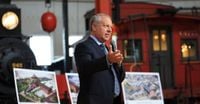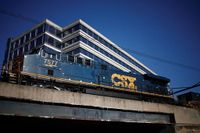CSX, one of North America’s largest freight railroads, stunned the industry this week by announcing a major leadership shake-up amid mounting investor pressure and a rapidly shifting competitive landscape. On Monday, September 29, 2025, the Jacksonville, Florida-based railroad declared that Steve Angel would take the helm as CEO, replacing Joe Hinrichs, who had led the company since 2022.
The move comes less than two months after activist investor Ancora Holdings publicly urged CSX to either seek a merger to keep pace with the blockbuster $85 billion Union Pacific–Norfolk Southern deal or oust its chief executive. According to AP News, Ancora’s leaders, Frederick D. DiSanto and James Chadwick, were blunt in their assessment: they believed Hinrichs “botched the opportunity” to merge with another railroad and may have even resisted the idea. Their hope now is that Angel, with his deep experience in mergers and acquisitions, will “be more aggressive at pursuing a deal and re-evaluate the railroad’s leadership team.”
Hinrichs, who arrived at CSX after a long career at Ford, had focused on mending fences with workers and labor unions following a bitter contract dispute. Yet, Ancora and other investors grew frustrated as CSX’s operating performance lagged and shareholder returns disappointed. Hinrichs ultimately resigned, clearing the way for Angel to step in on Sunday, September 28, 2025.
Steve Angel, 70, is no stranger to leading large, complex organizations through times of change. He brings 45 years of experience, having served as CEO of Linde and Praxair—industrial gas giants known for their global reach and major mergers. Earlier in his career, Angel also oversaw General Electric’s locomotive division, providing him with a relevant, if indirect, background in rail operations. As Reuters reported, Angel’s resume includes more than two decades at GE, where he was involved in locomotive and rail operations, and his leadership at Linde saw him execute one of the largest industrial mergers in history.
CSX’s board chairman, John Zillmer, expressed enthusiasm about the new appointment, calling Angel “a visionary in creating long-term value and an expert in guiding companies through significant transformation.” The board, he said, is “laser-focused on advancing CSX’s strategic priorities and maximizing shareholder value,” according to The New York Times.
CSX’s recent struggles weren’t solely due to leadership, though. Over the past year, the company grappled with two major disruptions: extensive repairs from Hurricane Helene and a significant tunnel renovation in Baltimore. Both projects were completed in September 2025, and analysts now expect CSX’s performance to improve in the fourth quarter. Tony Hatch, a freight rail analyst, told The New York Times, “They have real momentum.”
The timing of the leadership change is no coincidence. The entire North American rail industry has been rocked by the surprise announcement earlier in 2025 that Union Pacific and Norfolk Southern plan to merge, creating the country’s first coast-to-coast freight network. This deal, the largest in U.S. rail history, has fueled speculation that other major players—like CSX and BNSF—might be forced to consider mergers of their own. BNSF, owned by Warren Buffett’s Berkshire Hathaway, has so far declined to pursue a deal, with Buffett telling CNBC in August 2025 that he was not interested in bidding for CSX.
Ancora Holdings, which helped orchestrate leadership changes at Norfolk Southern earlier this year, has been vocal about its expectations for CSX. In a statement, Ancora’s executives argued, “With President Donald Trump and other policymakers recently expressing enthusiasm for the benefits of a transcontinental railroad, CSX and other Class I railroads have no choice but to embrace the industry’s new realities.” They praised Angel’s appointment, citing his “M&A pedigree and value creation record” as the right step for CSX.
Angel himself wasted no time setting out his agenda. In a statement released by CSX, he said, “My top priorities will be to ensure the safety of the railroad and our employees, deliver reliable service to our customers, and increase value for our shareholders.” He’s also set to benefit handsomely if he delivers results: Angel’s compensation package includes a $1.5 million base salary, a potential $13.5 million performance stock grant for 2026 if CSX meets certain targets, a separate $10 million stock grant vesting after three years based on performance, and retirement eligibility after three years. Should another railroad take control of CSX, he’s also entitled to a payout of triple his salary and target bonus.
Angel’s arrival has already sent positive signals to the market. CSX shares jumped more than 5% on Monday, September 29, 2025, following the announcement, according to AP News and The New York Times. In premarket trading, the stock was up about 3%, Reuters noted. Ancora, meanwhile, continues to increase its stake in CSX and hopes to develop a better relationship with the railroad going forward.
The challenge for Angel will be steering CSX through a period of intense industry consolidation and uncertainty. CFRA Research analyst Emily Nasseff Mitsch told AP News, “Angel brings exceptional credentials from 22 years at GE’s locomotive operations and demonstrated value creation, generating over 200% returns at Linde and Praxair while executing major industrial mergers. We believe this positions CSX for its next growth phase.” Most observers agree that CSX and BNSF could be at a disadvantage if the Union Pacific–Norfolk Southern merger is approved, since the new coast-to-coast giant will be able to shave more than a day off delivery times by eliminating handoffs between railroads in the middle of the country.
For now, CSX has said it is open to all methods to boost shareholder value, including potential mergers. Hedge fund Toms Capital Investment Management also requested a meeting with CSX’s board in August 2025 after acquiring a stake, signaling that investor scrutiny remains high. Still, some industry insiders believe that cooperative agreements—rather than outright mergers—could allow railroads to achieve many of the same benefits, though time will tell if that’s enough to satisfy investors hungry for bigger gains.
Outgoing CEO Joe Hinrichs, who was not made available for interviews, reflected on his tenure in a LinkedIn post, writing, “With the major projects now opening back up, there is tremendous opportunity to continue leading and improving.” But with Angel now in charge, the pressure is on for CSX to prove it can adapt, innovate, and thrive in a new era of railroading—one where the stakes have never been higher and the competition never fiercer.
As the dust settles on this leadership transition, all eyes will be on Angel and the CSX board to see whether they can deliver the transformation investors are demanding—and whether America’s railroads are truly on the cusp of a new age of consolidation and coast-to-coast service.





